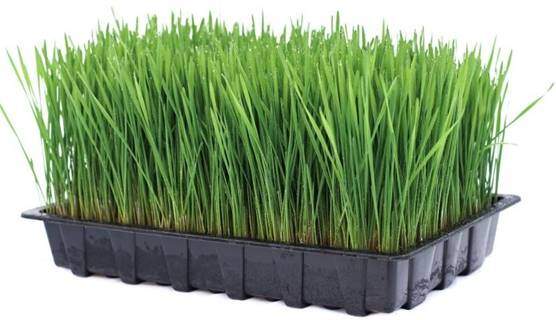Wheatgrass is a name given to first leaves, sprout, or young shoots of bread or common wheat plant (T. aestivum). Of course, there are many other species and varieties, including Durum, Einkorn, Spelt, Khorasan, among others.
However, this term may also refer to the creeping couch grass or any that resemble it. We will not be dwelling much on these grasses.
To human beings, these young shoots serve as food or dietary supplement, including their juice. They have various nutrients, the likes of amino acids, minerals, vitamins, chlorophyll, and amino acids, with many scientifically unproven health benefits.

Can bunnies eat wheatgrass?
Yes. Rabbits can eat wheatgrass as well as its hay but not its bread or grains. It is good for these pets. While looking at whether rabbits can eat grass or not, we made that fact clear. However, we felt it vital that we further emphasize it.
Wheatgrass is nutritious as it has vitamins A, C, E, K, as well as thiamin, riboflavin, niacin, pantothenic acid, vitamin B6, potassium, zinc, iron, copper, selenium, magnesium, dietary fiber and so on.
However, just because it is nutritious doesn’t automatically qualify it as an ideal food to give your rabbits. You need to know how to offer it to your furry friends properly.
Feeding wheatgrass to your
To begin with, a well-balanced diet for your rabbits should have not less than 80% hay, especially timothy hay with brands such as Small Pet Select 2nd Cutting Timothy Hay Pet Food or Standlee Premium Western Forage Timothy Grass sure not to let you down.
However, being a grass, most people may want to replace wheatgrass with hay. Don’t because it is less in fiber compared and will not effectively wear your rabbit’s teeth or promote healthy gut motility and digestion.
Instead, make it only a part of the fresh plants you feed to your pets and give them a variety for maximum nutritional benefits, including some safe fruit treats. A good mixture should have 3-5 different veggies and plants, with most being low in oxalic acids.
To control the amount they eat, limit the duration they graze or amount you offer to them. Too much will be unhealthy. Also, avoid shredding it as there is no point in doing so as this degrades the much-needed fiber.
Furthermore, a successful introduction of any new food requires time and a gradual increase in the amount given over a week to two weeks. Do the same to wheatgrass to let them adjust while you check for any signs of stomach troubles. In case of any, discontinue.
If you grow wheat, avoid feeding your pets to golden-turned straws as they are less in nutrients. Feed it to them while it is green. Instead, use the straws as a bedding for your rabbits.
Finally, ensure your source is pesticides, insecticides, or herbicide free. It shouldn’t also have any preservatives.
Growing your own at home
Wheatgrass makes an excellent addition to your bunny’s diet, is easy to cultivate, and grows fast. You can grow it at home. You don’t need a garden, just pots or trays and you are good to go.
Begin by buying good quality wheatgrass seeds, get some organic soil, and a tray or pot. Add a few inches soil, spray some water, layer your seeds, and cover with topsoil and fritz more water.
Cover it loosely and place your tray in indirect sunlight. Once they begin sprouting, remove the cover, take them to direct sunlight, and continue watering them.
Conclusion
While we have said wheatgrass is safe for rabbits and they can eat it, including daily. Keep the amounts small and mix with veggies and other safe plants and keep varying what you give them.
